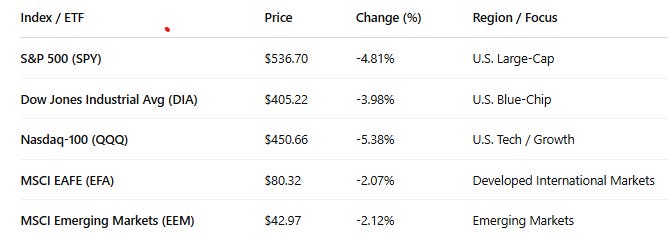Tariffs, Tension, and Turbulence: Global Markets React to Trump’s Trade Shock
By Andrew J. Willms | The Milwaukee Company | April 3, 2025
In Brief:
President Trump’s new tariff regime imposes a 10% blanket duty on all U.S. imports, with targeted rates up to 49% on select countries, sparking fears of a global trade war.
Markets tumbled globally, led by sharp losses in U.S. equities and weakness in export-heavy international indices.
Investors are reassessing positioning, emphasizing global diversification, cash flow durability, and discipline amid policy-driven volatility.
President Donald Trump's sweeping tariff announcement has reverberated through global markets, prompting a rapid reassessment of growth expectations, inflation risks, and investment positioning. The policy introduces a 10% universal tariff on all imported goods, along with country-specific tariffs of up to 49% on select imports from nations including China, Mexico, and several European countries.
Far from a tactical move, these tariffs appear to be a structural element of the administration’s economic strategy—intended to shift global supply chains, rebalance trade flows, and revive U.S. manufacturing. But markets, which had been bracing for clarity, instead absorbed a shock. Trading partners have already signaled intentions to respond in kind, heightening the risk of retaliatory actions that could dampen global growth and further disrupt supply chains
Market Response
Equity markets responded swiftly and negatively. The S&P 500 fell nearly 5% on the day, while the Nasdaq lost 6%, underscoring the market’s sensitivity to sudden shifts in trade policy. Tech, industrials, and consumer discretionary names led the decline. International equities also slipped as investors moved to reduce exposure to escalating geopolitical risk.
Losses were most pronounced in technology and consumer discretionary sectors, though selling pressure was widespread. International equities fell as well, though to a lesser extent, aided by more modest valuations and reduced exposure to U.S.-centric trade frictions.
Investor Considerations
The scale and abruptness of these tariffs have raised concerns about their potential to disrupt global supply chains, increase consumer prices, and dampen economic growth. That said, although today’s moves were significant, they do not yet constitute a breakdown of long-term trends. For example, the S&P 500’s 50-day average is still above its 200-day counterpart, although the gap is closing and may soon turn negative if stocks fall further in the days ahead.
Moreover, U.S. stocks are now down more than 8% year to date (based on the S&P 500 Index), but bonds have rallied. The Vanguard Total Bond Market ETF (BND) is up 3.6% so far this year.
Diversification across asset classes has been a tough sell in recent years as U.S. equities—particularly tech—outperformed dramatically. But 2025 is once again proving the value of not putting all one’s investment eggs in a single basket. It is a principle that is a key component of The Milwaukee Company’s philosophy.
Conclusion
The new U.S. tariff regime has upended market expectations and introduced meaningful new variables into the global investment equation. While the immediate market reaction was sharp, it was not irrational—markets are doing their job by repricing risk.
For long-term investors, the challenge now is not to predict policy, but to adapt to it with clarity and discipline. That means respecting volatility without fearing it and seeking resilience over reaction. If history is any guide, the eventual recovery may favor those who stay invested with purpose.


